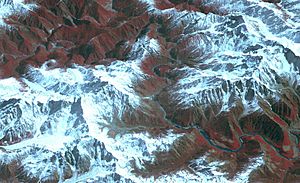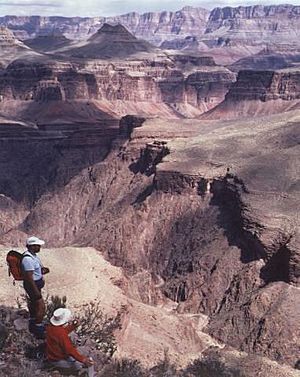Canyon facts for kids

A canyon (sometimes called a cañon or gorge) is a very deep valley with steep sides, often carved out by a river. Imagine a giant crack in the Earth! Rivers naturally try to reach a lower level, similar to the body of water they flow into. This process helps create canyons over millions of years.
Most canyons are formed by erosion, which is when natural forces like water and wind wear away rock and soil. The steep walls of a canyon form because some rocks are harder and resist erosion better than others. Canyons are more common in dry areas because physical weathering (like wind and water) has a bigger effect there. When water seeps into cracks in rocks and freezes, it expands and pushes the rocks apart. This can cause large pieces of the canyon walls to break off, a process called frost wedging. Canyon walls are often made of strong rocks like sandstone or granite.
Some canyons even form underwater! These are called submarine canyons and are usually found near where rivers meet the ocean. The word canyon comes from the Spanish word cañón. In the United States, canyon is commonly used, while in Europe and Oceania, gorge is more typical.
Contents
How Canyons Form
Canyons are mostly shaped by the power of flowing water. Rivers carry rocks and soil, slowly grinding away at the land over a very long time.
River Power and Rock Types
As a river flows, it constantly cuts down into the land. This is how it reaches a lower elevation, like the sea level. Harder rock layers, which are more resistant to erosion, form the steep cliffs you see in a canyon. Softer rocks, like shales, are worn away more easily by the water and wind.
Freezing Water and Weathering
Another way canyons are shaped is by freezing water. Water gets into tiny cracks in the rocks. When this water freezes, it expands, pushing the cracks wider. Over time, this can cause large chunks of rock to break off the canyon walls. This process is called frost wedging.
Entrenched Rivers
Sometimes, large rivers flow through canyons because the land around them slowly lifted up over time. These are called entrenched rivers. They can't easily change their path because they are so deeply cut into the landscape. The Colorado River in the Southwestern United States and the Snake River in the Northwestern United States are good examples of this.
Canyons in Limestone Areas
Canyons can also form in areas with limestone rock. Limestone can dissolve in water, which creates cave systems underground. If these caves collapse, they can leave behind a canyon. You can see examples of this in places like the Mendip Hills in England.
Types of Canyons
Canyons aren't all the same! They can look different depending on how they formed and where they are.
Mountain Canyons
A canyon can also be a deep split between two mountain peaks, like those found in the Rocky Mountains or the Himalayas. A river or stream, along with erosion, usually carves out these splits. Provo Canyon in Utah and parts of Yosemite National Park in California are examples of mountain canyons.
Box and Slot Canyons
Canyons within mountains or gorges that only have an opening on one side are called box canyons. Imagine a box with one side missing! Slot canyons are another type. They are very narrow, often with smooth, tall walls, making them look like a slot in the ground.
Famous Canyons Around the World
There are many amazing canyons across the globe, each with its own unique features.
The Grand Canyon
One of the most famous canyons is the Grand Canyon in Arizona, USA. It's about one mile deep on average and incredibly vast. For thousands of years, the Ancestral Puebloans (ancient people) built homes in the cliffs of canyons in the southwestern United States. This makes canyons important places for studying history.
Deepest Canyons
The Yarlung Tsangpo Grand Canyon (or Tsangpo Canyon) in Tibet is considered one of the deepest canyons in the world, reaching about 18,000 feet deep. It's also a bit longer than the Grand Canyon. However, some people believe the Kali Gandaki Gorge in Nepal is the deepest, with a huge 21,000-foot difference between the river and the surrounding mountain peaks.
Other Notable Canyons
The second largest canyon, and the biggest in Africa, is Fish River Canyon in Namibia.
Largest Canyons
It's tricky to say exactly which canyon is the "largest" because you could measure it by depth, length, or the total area of its system. Also, some huge canyons in the Himalaya mountains are very hard to reach, so they aren't always included in "biggest canyon" lists. The same goes for defining the "deepest canyon," especially if you compare mountain canyons (which have less clear "rims") with canyons cut through flat areas.
List of Canyons
- Black Canyon of the Gunnison, Colorado, USA
- Blyde River Canyon, Mpumalanga, South Africa
- Canyon de Chelly, Arizona, USA
- Canyon Sainte-Anne, Quebec, Canada
- Charyn Canyon, Kazakhstan
- Harmanköy Canyon, Bilecik Turkey
- Chicamocha Canyon, Santander, Colombia
- Colca Canyon, Arequipa, Peru
- Copper Canyon, Chihuahua, Mexico
- Cotahuasi Canyon, Arequipa, Peru
- Fish River Canyon, Namibia
- Fraser Canyon, British Columbia, Canada
- Grand Canyon of Torotoro, Torotoro, Potosi Department, Bolivia
- Grand Canyon of the Yellowstone, Wyoming, USA
- Guartelá Canyon, Paraná, Brazil
- Hells Canyon, Idaho and Oregon, USA
- Horseshoe Canyon, Alberta, Canada
- Huasteca Canyon, Monterrey, Mexico
- Kanionet e Skraparit, Albania
- Kings Canyon (Northern Territory), Australia
- Little River Canyon, Alabama, USA
- Logan Canyon, Utah, USA
- Matka Canyon, Republic of Macedonia
- Nfeye Canyon, Portugal
- Nine Mile Canyon, Utah, USA
- Ouimet Canyon, Ontario, Canada
- Palo Duro Canyon, Texas, USA
- Rugova Canyon, Kosovo, Europe
- Saturban canyon, Santander, Colombia
- Somoto Canyon, Somoto, Madriz, Nicaragua
- Shnizow Canyon, Uşak, Turkey
- St. Christopher's Canyon (Cañon de San Cristobal), Barranquitas/Aibonito, Puerto Rico
- Sumidero Canyon, Chiapas, Mexico
- Tara River Canyon, Montenegro, Europe
- Valla Canyon, Kure,Turkey
- Waimea Canyon, Hawaii, USA
- Yarlung Zangbo Grand Canyon, Tibet Autonomous Region, China
- Tara River Canyon, Montenegro, Europe
Images for kids
-
The Grand Canyon, Arizona, at the meeting point of the Colorado River and Little Colorado River.
-
Fish River Canyon, Namibia.
-
Oribi Gorge, South Africa.
-
Green River overlook, Canyonlands National Park, Utah, U.S.
-
One of the Three Gorges of the Yangtze river, China.
-
The gorge of the Kabul River in Afghanistan.
-
Cheddar Gorge, England.
-
Le cirque de la Madeleine, Gorges de l'Ardèche, France.
-
Sulak Canyon in Dagestan.
-
Buky Canyon, Ukraine.
-
Jamison Valley, Blue Mountains National Park, Australia.
See also
 In Spanish: Cañón (geomorfología) para niños
In Spanish: Cañón (geomorfología) para niños



















